小学英语常见介词用法辨析及习题
- 格式:docx
- 大小:82.84 KB
- 文档页数:7
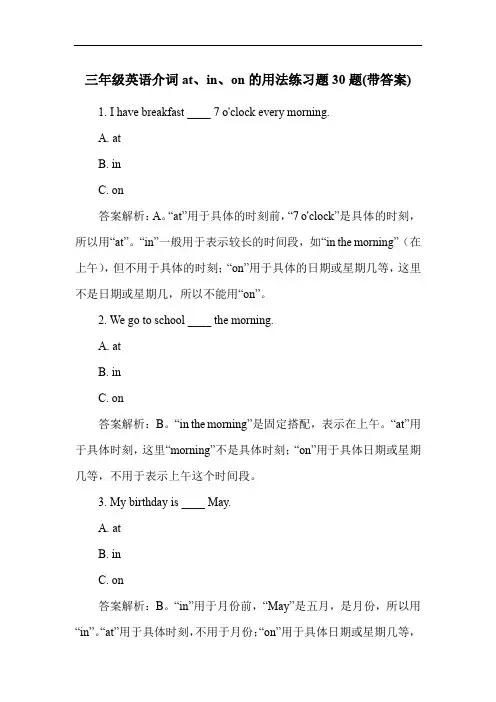
三年级英语介词at、in、on的用法练习题30题(带答案)1. I have breakfast ____ 7 o'clock every morning.A. atB. inC. on答案解析:A。
“at”用于具体的时刻前,“7 o'clock”是具体的时刻,所以用“at”。
“in”一般用于表示较长的时间段,如“in the morning”(在上午),但不用于具体的时刻;“on”用于具体的日期或星期几等,这里不是日期或星期几,所以不能用“on”。
2. We go to school ____ the morning.A. atB. inC. on答案解析:B。
“in the morning”是固定搭配,表示在上午。
“at”用于具体时刻,这里“morning”不是具体时刻;“on”用于具体日期或星期几等,不用于表示上午这个时间段。
3. My birthday is ____ May.A. atB. inC. on答案解析:B。
“in”用于月份前,“May”是五月,是月份,所以用“in”。
“at”用于具体时刻,不用于月份;“on”用于具体日期或星期几等,这里不是具体日期,不能用“on”。
4. She has a party ____ Saturday.A. atB. inC. on答案解析:C。
“on”用于星期几前,“Saturday”是星期六,所以用“on”。
“at”用于具体时刻,不用于星期几;“in”用于较长时间段,不用于星期几。
5. They play football ____ the afternoon.A. atB. inC. on答案解析:B。
“in the afternoon”是固定搭配,表示在下午。
“at”用于具体时刻,这里“afternoon”不是具体时刻;“on”用于具体日期或星期几等,不用于表示下午这个时间段。
6. He goes to bed ____ 9:30.A. atB. inC. on答案解析:A。
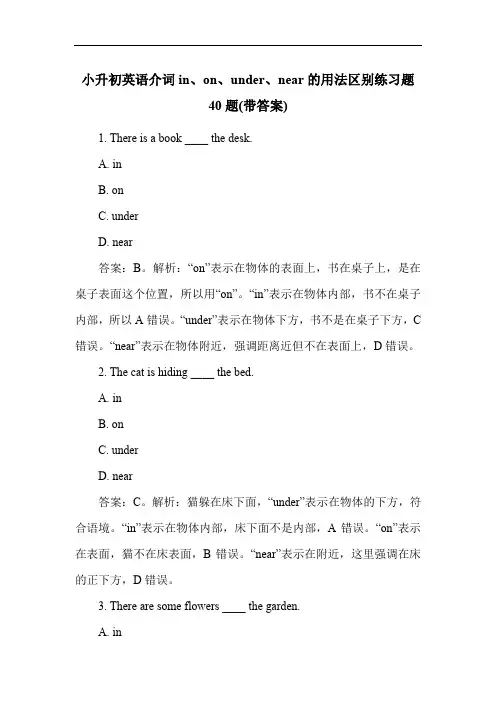
小升初英语介词in、on、under、near的用法区别练习题40题(带答案)1. There is a book ____ the desk.A. inB. onC. underD. near答案:B。
解析:“on”表示在物体的表面上,书在桌子上,是在桌子表面这个位置,所以用“on”。
“in”表示在物体内部,书不在桌子内部,所以A错误。
“under”表示在物体下方,书不是在桌子下方,C 错误。
“near”表示在物体附近,强调距离近但不在表面上,D错误。
2. The cat is hiding ____ the bed.A. inB. onC. underD. near答案:C。
解析:猫躲在床下面,“under”表示在物体的下方,符合语境。
“in”表示在物体内部,床下面不是内部,A错误。
“on”表示在表面,猫不在床表面,B错误。
“near”表示在附近,这里强调在床的正下方,D错误。
3. There are some flowers ____ the garden.A. inB. onC. underD. near答案:A。
解析:在花园里有一些花,“in”用于表示在一个封闭空间内部,花园是一个空间,花在花园里面,所以用“in”。
“on”表示在表面,不符合,B错误。
“under”表示在下方,C错误。
“near”表示在附近,D错误。
4. My schoolbag is ____ the chair.A. inB. onC. underD. near答案:D。
解析:我的书包在椅子附近,“near”表示靠近、在附近的意思。
“in”表示在内部,书包不在椅子内部,A错误。
“on”表示在表面,这里不是在椅子表面,B错误。
“under”表示在下方,C错误。
5. There is a lamp ____ the table.A. inB. onC. underD. near答案:B。
解析:灯在桌子上,在桌子表面,用“on”。
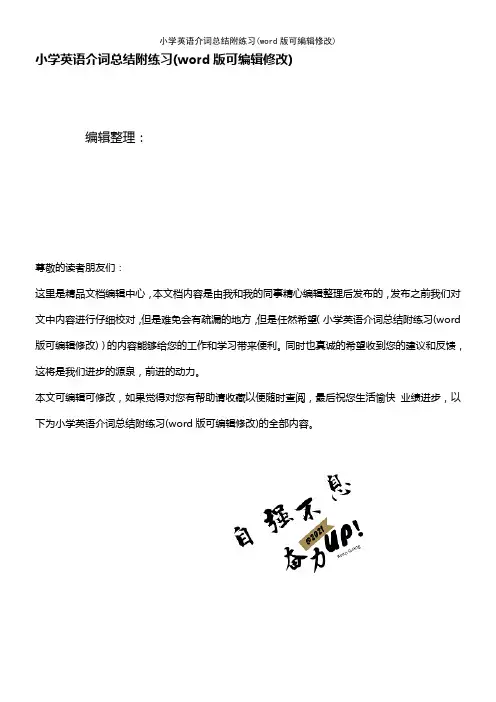
小学英语介词总结附练习(word版可编辑修改)编辑整理:尊敬的读者朋友们:这里是精品文档编辑中心,本文档内容是由我和我的同事精心编辑整理后发布的,发布之前我们对文中内容进行仔细校对,但是难免会有疏漏的地方,但是任然希望(小学英语介词总结附练习(word 版可编辑修改))的内容能够给您的工作和学习带来便利。
同时也真诚的希望收到您的建议和反馈,这将是我们进步的源泉,前进的动力。
本文可编辑可修改,如果觉得对您有帮助请收藏以便随时查阅,最后祝您生活愉快业绩进步,以下为小学英语介词总结附练习(word版可编辑修改)的全部内容。
小学英语介词总结介词(Preposition)一、概述介词是英语中很活跃的词,一般置于名词之前。
它常和名词或名词性词语构成介词短语。
同一个介词常和不同的词语搭配形成固定搭配,表示不同意义。
二、常用介词的基本用法at①表示时间: I go to school at seven every day 我每天早上7点去上学。
②表示在某一具体地点: He is standing at the bus stop 他站在公共汽车站。
③表示动作的方向、目标: Let me have a look at the picture 让我看看这幅图。
④用于某些固定搭配: at once 立刻、马上 at last 最后at the same time 同时 at first 开始时not at all 一点也不about①表示大约时间: I's about six o'clock now. 现在大约6点钟了。
②表示地点;在……周围: Everthing about me is so beautiful 我周围的一切都那么美好。
③关于,对于: We are talking about the news。
我们正在谈论新闻。
after①在……之后: After dinner I watch TV. 晚饭后我看电视.②在……后面: He came into the room after me. 他在我后面进了房间。
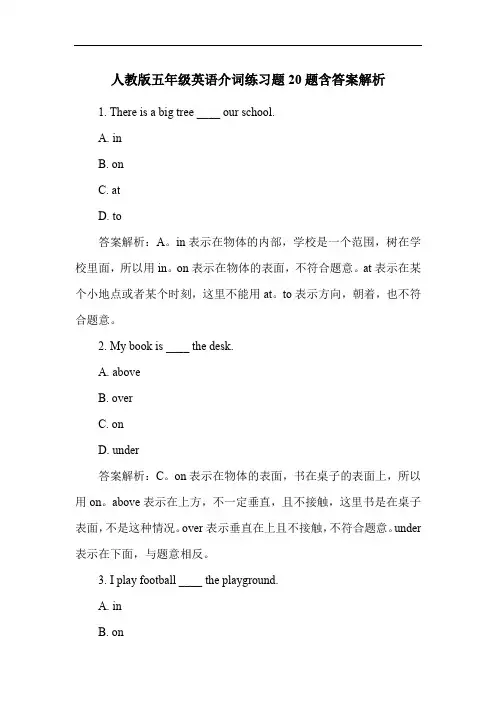
人教版五年级英语介词练习题20题含答案解析1. There is a big tree ____ our school.A. inB. onC. atD. to答案解析:A。
in表示在物体的内部,学校是一个范围,树在学校里面,所以用in。
on表示在物体的表面,不符合题意。
at表示在某个小地点或者某个时刻,这里不能用at。
to表示方向,朝着,也不符合题意。
2. My book is ____ the desk.A. aboveB. overC. onD. under答案解析:C。
on表示在物体的表面,书在桌子的表面上,所以用on。
above表示在上方,不一定垂直,且不接触,这里书是在桌子表面,不是这种情况。
over表示垂直在上且不接触,不符合题意。
under 表示在下面,与题意相反。
3. I play football ____ the playground.A. inB. onC. atD. to答案解析:A。
in表示在一个封闭的空间内,操场是一个较大的封闭空间,在操场里踢足球用in。
on表示在表面,操场是一个区域,不是强调表面。
at表示小地点或者时刻,不合适。
to表示方向,不符合。
4. She goes to school ____ foot.A. byB. onC. withD. in答案解析:B。
on foot是固定短语,表示步行。
by后面一般接交通工具,如by bus,by bike等,这里不能用by。
with表示和一起或者用某种工具,不符合题意。
in表示在里面,也不符合。
5. The cat is hiding ____ the box.A. inB. onC. atD. to答案解析:A。
in表示在物体的内部,猫躲在盒子里面,所以用in。
on表示在表面,不符合。
at表示小地点或者时刻,不合适。
to表示方向,不符合。
6. There are some pictures ____ the wall.A. inB. onC. atD. to答案解析:B。
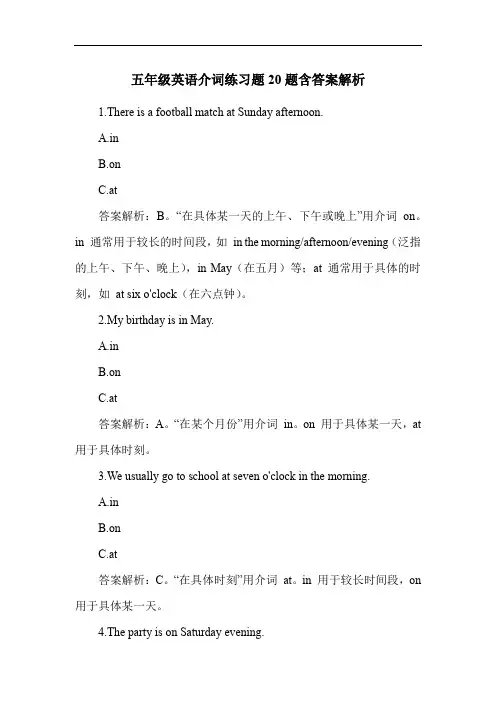
五年级英语介词练习题20题含答案解析1.There is a football match at Sunday afternoon.A.inB.onC.at答案解析:B。
“在具体某一天的上午、下午或晚上”用介词on。
in 通常用于较长的时间段,如in the morning/afternoon/evening( 泛指的上午、下午、晚上),in May 在五月)等;at 通常用于具体的时刻,如at six o'clock 在六点钟)。
2.My birthday is in May.A.inB.onC.at答案解析:A。
“在某个月份”用介词in。
on 用于具体某一天,at 用于具体时刻。
3.We usually go to school at seven o'clock in the morning.A.inB.onC.at答案解析:C。
“在具体时刻”用介词at。
in 用于较长时间段,on 用于具体某一天。
4.The party is on Saturday evening.A.inB.onC.at答案解析:B。
“在具体某一天的晚上”用介词on。
in 用于较长时间段,at 用于具体时刻。
5.Mother's Day is in May.A.inB.onC.at答案解析:A。
“在某个月份”用介词in。
on 用于具体某一天,at 用于具体时刻。
6.We have an English class at nine o'clock.A.inB.onC.at答案解析:C。
“在具体时刻”用介词at。
in 用于较长时间段,on 用于具体某一天。
7.My father's birthday is on July 15th.A.inB.onC.at答案解析:B。
“在具体的日期”用介词on。
in 用于较长时间段,at 用于具体时刻。
8.We go swimming in summer.A.inB.onC.at答案解析:A。
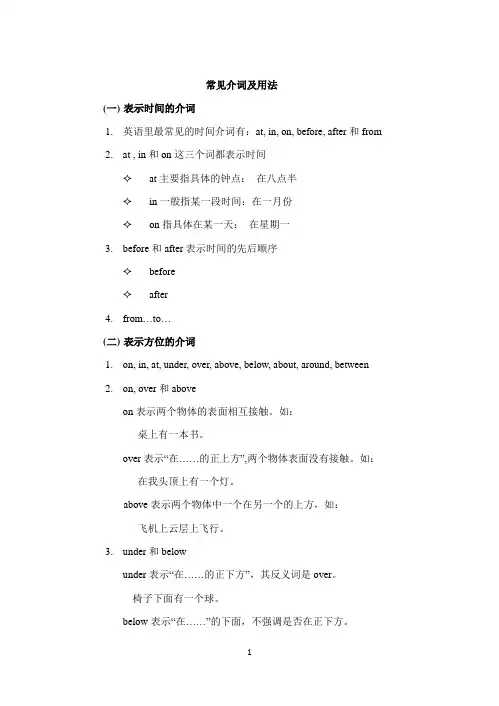
常见介词及用法(一)表示时间的介词1.英语里最常见的时间介词有:at, in, on, before, after和from2.at , in和on这三个词都表示时间✧at主要指具体的钟点:在八点半✧in一般指某一段时间:在一月份✧on指具体在某一天:在星期一3.before和after表示时间的先后顺序✧before✧after4.from…to…(二)表示方位的介词1.on, in, at, under, over, above, below, about, around, between2.on, over和aboveon表示两个物体的表面相互接触。
如:桌上有一本书。
over表示“在……的正上方”,两个物体表面没有接触。
如:在我头顶上有一个灯。
above表示两个物体中一个在另一个的上方,如:飞机上云层上飞行。
3.under和belowunder表示“在……的正下方”,其反义词是over。
椅子下面有一个球。
below表示“在……”的下面,不强调是否在正下方。
他们家的房子在我家的下面。
4.in表示位置“在……里面”,也可以用来表示在一个很大的空间内。
孩子们正在房间里玩。
书都在我的书包里。
5.at表示“在……旁边”。
老师正在桌边。
6.around表示“在……周围”。
There are lots of flowers around the house. 房子周围有许多花。
7.behind表示“在……的后面”。
别躲在树后。
8.in front of表示“在……的前面”。
9.between表示“在两者之间”。
(三)表示动向的介词。
1.常见的动向介词有:into, out of, up, down, from, to, through, along等。
2.into和out ofinto,out of简跳进了水里。
3.up和down:他经常爬山。
(四)表示方式的介词常见的表示方式的介词有:by, with, in等。
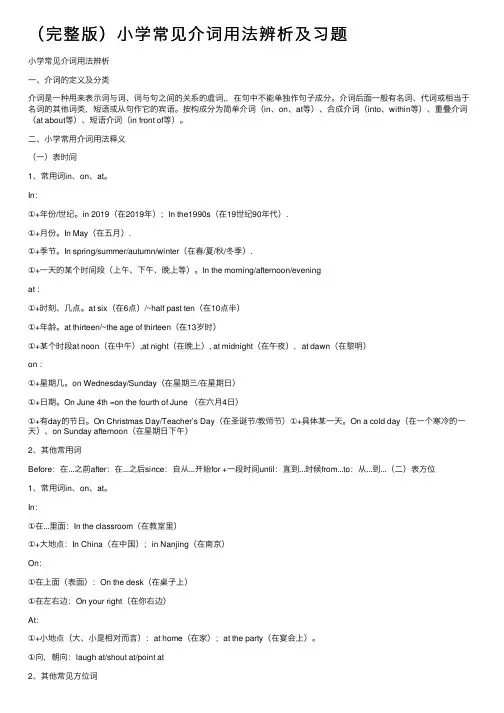
(完整版)⼩学常见介词⽤法辨析及习题⼩学常见介词⽤法辨析⼀、介词的定义及分类介词是⼀种⽤来表⽰词与词、词与句之间的关系的虚词,,在句中不能单独作句⼦成分。
介词后⾯⼀般有名词、代词或相当于名词的其他词类,短语或从句作它的宾语。
按构成分为简单介词(in、on、at等)、合成介词(into、within等)、重叠介词(at about等)、短语介词(in front of等)。
⼆、⼩学常⽤介词⽤法释义(⼀)表时间1、常⽤词in、on、at。
In:①+年份/世纪。
in 2019(在2019年);In the1990s(在19世纪90年代).①+⽉份。
In May(在五⽉).①+季节。
In spring/summer/autumn/winter(在春/夏/秋/冬季).①+⼀天的某个时间段(上午、下午、晚上等)。
In the morning/afternoon/eveningat :①+时刻、⼏点。
at six(在6点)/~half past ten(在10点半)①+年龄。
at thirteen/~the age of thirteen(在13岁时)①+某个时段at noon(在中午),at night(在晚上), at midnight(在午夜),at dawn(在黎明)on :①+星期⼏。
on Wednesday/Sunday(在星期三/在星期⽇)①+⽇期。
On June 4th =on the fourth of June (在六⽉4⽇)①+有day的节⽇。
On Christmas Day/Teacher’s Day(在圣诞节/教师节)①+具体某⼀天。
On a cold day(在⼀个寒冷的⼀天)、on Sunday afternoon(在星期⽇下午)2、其他常⽤词Before:在...之前after:在...之后since:⾃从...开始for +⼀段时间until:直到...时候from...to:从...到...(⼆)表⽅位1、常⽤词in、on、at。
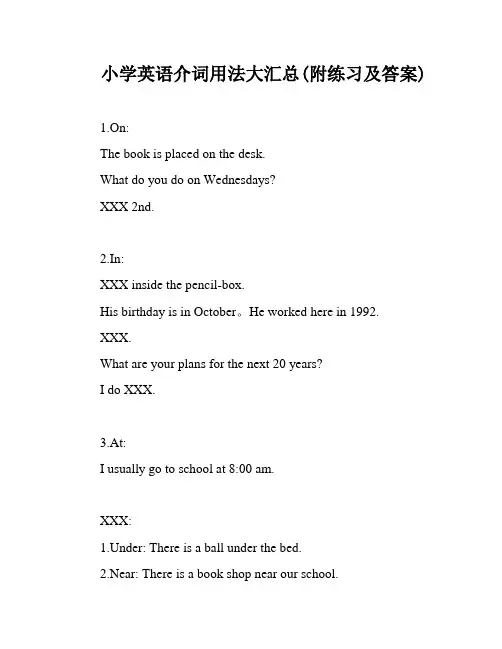
小学英语介词用法大汇总(附练习及答案)1.On:The book is placed on the desk.What do you do on Wednesdays?XXX 2nd.2.In:XXX inside the pencil-box.His birthday is in October。
He worked here in 1992.XXX.What are your plans for the next 20 years?I do XXX.3.At:I usually go to school at 8:00 am.XXX:1.Under: There is a ball under the bed.2.Near: There is a book shop near our school.3.In front of: A boy is standing in front of the house.4.XXX: A XXX.5.Next to: There is a bus n next to No.13 Middle School.6.Over: A bridge is over the river.7.On the left: The bookstore is on the left.8.On the right: The hospital is on the right.There XXX een Class One and Class Three。
9.Sharks can dive into the deep。
cold water。
10.(1) XXX2) What does he look like。
11.(1) It's approximately 6:00 now。
2) What about。
How about。
专项练一、填空1.The first day of school2.On the school playground3.Attending classes4.Every Wednesday5.Visiting a farm6.Pulling carrots7.A lot of fruit trees8.Living in a town9.On the weekends10.In the sitting room11.On the 4th of November12.Look at them13.Chinese New Year14.Christmas Day15.Dress up in costumes二、选择题1.On the afternoon of May。
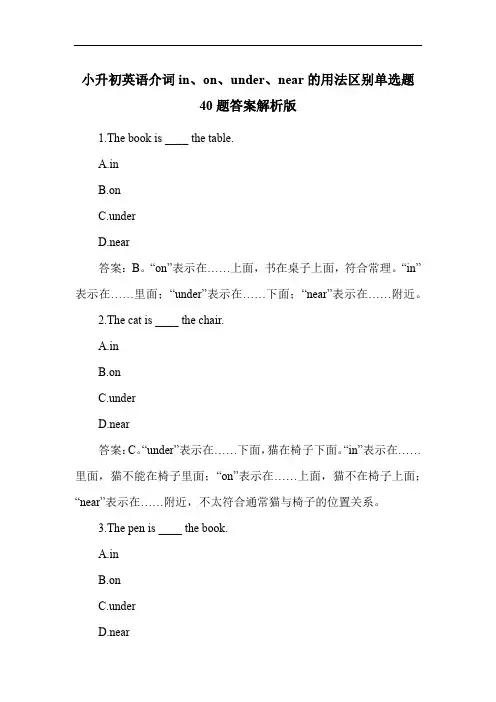
小升初英语介词in、on、under、near的用法区别单选题40题答案解析版1.The book is ____ the table.A.inB.onC.underD.near答案:B。
“on”表示在……上面,书在桌子上面,符合常理。
“in”表示在……里面;“under”表示在……下面;“near”表示在……附近。
2.The cat is ____ the chair.A.inB.onC.underD.near答案:C。
“under”表示在……下面,猫在椅子下面。
“in”表示在……里面,猫不能在椅子里面;“on”表示在……上面,猫不在椅子上面;“near”表示在……附近,不太符合通常猫与椅子的位置关系。
3.The pen is ____ the book.A.inB.onC.underD.near答案:B。
“on”表示在……上面,笔在书上。
“in”表示在……里面,笔不能在书里面;“under”表示在……下面,不符合;“near”表示在……附近,不如在书上确切。
4.The ball is ____ the box.A.inB.onC.underD.near答案:A。
“in”表示在……里面,球在盒子里面。
“on”表示在……上面,球不在盒子上面;“under”表示在……下面,球不在盒子下面;“near”表示在……附近,不准确。
5.The flower is ____ the vase.A.inB.onC.underD.near答案:A。
“in”表示在……里面,花在花瓶里面。
“on”表示在……上面,花不在花瓶上面;“under”表示在……下面,花不在花瓶下面;“near”表示在……附近,不准确。
6.The picture is ____ the wall.A.inB.onC.underD.near答案:B。
“on”表示在……上面,画在墙上。
“in”表示在……里面,画不能在墙里面;“under”表示在……下面,画不在墙下面;“near”表示在……附近,不准确。
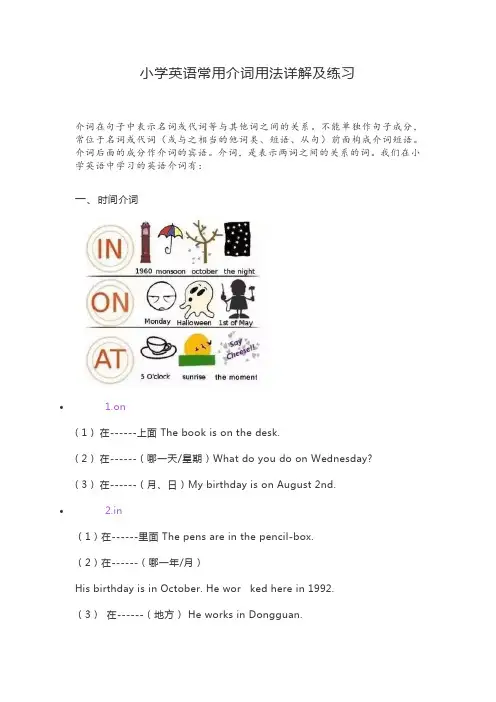
小学英语常用介词用法详解及练习介词在句子中表示名词或代词等与其他词之间的关系。
不能单独作句子成分,常位于名词或代词(或与之相当的他词类、短语、从句)前面构成介词短语。
介词后面的成分作介词的宾语。
介词,是表示两词之间的关系的词。
我们在小学英语中学习的英语介词有:一、时间介词• 1.on( 1 ) 在------上面 The book is on the desk.( 2 ) 在------(哪一天/星期)What do you do on Wednesday?( 3 ) 在------(月、日)My birthday is on August 2nd.• 2.in(1)在------里面 The pens are in the pencil-box.(2)在------(哪一年/月)His birthday is in October. He wor ked here in 1992.(3)在------(地方) He works in Dongguan.•(4)在------之内 What are you going to do in 20 years?•(5)在------(早上、下午、晚上)I do morning exercises in the morning every day.I usually play basketball in the afternoon.I often do my homework in the evening.• 3.at(1)在------(点钟)I usually go to school at 8:00 am.(2)在中午 at noon二、方位介词• 1. under 在------底下 There is a ball under the bed.• 2. near 在------附近 There is a book shop near ourschool.• 3. in front of在------前面A boy is standing in front of the house.• 4. beside 在------旁边 A football is beside thedoor.• 5. next to 紧挨着 There is a bus station next to No. 13 Middle School.• 6. over 在------正上方 A bridge is over the river.•7. on the left在------左边 The bookstore is on the left.•8. on the right在------右边The hospital is on the right.•9. before在……之前 Mike sits before me.•10. after在------以后 He went home after school.•11. in the middle在------中间The road is in the middle.•12. at(1)在------(小地方) I am at school today.I was at home yesterday.(2)看一看 Look at the blackboard.•13. behind 在------后面There is a broom behind the door.。
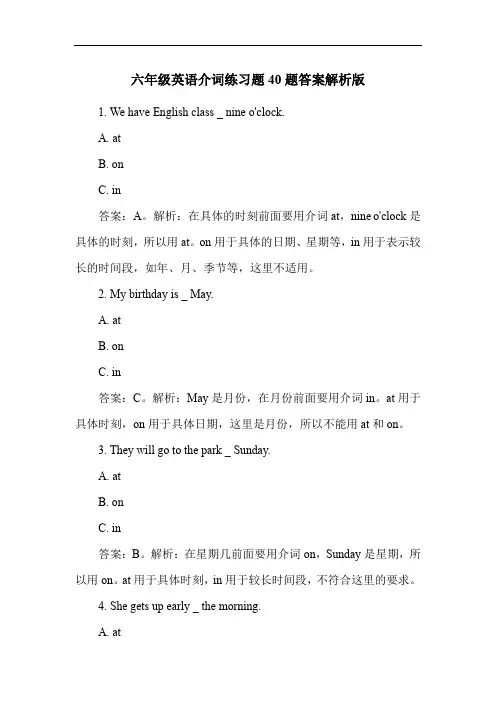
六年级英语介词练习题40题答案解析版1. We have English class _ nine o'clock.A. atB. onC. in答案:A。
解析:在具体的时刻前面要用介词at,nine o'clock是具体的时刻,所以用at。
on用于具体的日期、星期等,in用于表示较长的时间段,如年、月、季节等,这里不适用。
2. My birthday is _ May.A. atB. onC. in答案:C。
解析:May是月份,在月份前面要用介词in。
at用于具体时刻,on用于具体日期,这里是月份,所以不能用at和on。
3. They will go to the park _ Sunday.A. atB. onC. in答案:B。
解析:在星期几前面要用介词on,Sunday是星期,所以用on。
at用于具体时刻,in用于较长时间段,不符合这里的要求。
4. She gets up early _ the morning.A. atC. in答案:C。
解析:在早上、下午、晚上这些时间段前面要用介词in,in the morning是固定搭配。
at用于具体时刻,on用于具体日期等,这里不合适。
5. We usually have dinner _ 6:30 p.m.A. atB. onC. in答案:A。
解析:6:30 p.m.是具体的时刻,在具体时刻前面要用介词at。
on用于具体日期等,in用于较长时间段,这里不能用on和in。
6. The concert will be held _ July 10th.A. atB. onC. in答案:B。
解析:July 10th是具体的日期,在具体日期前面要用介词on。
at用于具体时刻,in用于月份等较长时间段,这里不能用at 和in。
7. He often reads books _ the weekend.A. atB. on答案:A。
小学英语介词的用法及专项练习介词的定义和作用介词是英语中一类重要的词性,用于连接名词、代词、动词或者其他介词与其他成分之间的关系。
介词可以表达方向、位置、原因、时间等等。
常见的英语介词有:in, on, at, for, with, by, from, to, over, under 等。
介词的用法1. 表示地点表示地点- in: 在某个区域或范围内- The cat is in the box.(猫在盒子里。
)- on: 在某个平面或表面上- The book is on the table.(书在桌子上。
)- at: 在某个具体的位置- She is waiting at the bus stop.(她在公交车站等待。
)2. 表示时间表示时间- at: 表示具体的时间点- The meeting starts at 9 o'clock.(会议在9点开始。
)- on: 表示某一天或日期- I have an appointment on Monday.(我在星期一有个约会。
)- in: 表示一段时间内- They will go on vacation in July.(他们将在七月份去度假。
)3. 表示原因表示原因- for: 表示目的或理由- We go to the park for a picnic.(我们去公园野餐。
)4. 表示方式表示方式- with: 表示伴随或使用- She writes with a pen.(她用钢笔写字。
)5. 表示运动表示运动- from...to: 表示由某个地方到另一个地方- He walked from home to the school.(他从家里走到学校。
)介词练请根据句子的意思,选择适当的介词填空。
1. The dog is __ the yard.(狗在院子里。
)2. My birthday is __ Sunday.(我的生日在星期天。
语法——介词in on atPart 1:学问点一、介词:是一种虚词,在句子中表示名词或代词与其他词之间的关系,不能单独做为句子成分,常位于名词或代词前面构成介词短语。
二、具体用法:常用介词1.in(1)表示方位:在……里面例句:There are three books in my bag.我书包里有三本书。
(2)表示地点:A.表示在大地方例句:I live in Hangzhou.我住在杭州。
B.表示属于该范围例句:Hei Longji ang lies in the north of China.黑龙江在中国北部。
(3)表示时间:A.表示一段时间(比较长)例:in summer在夏天in 2021在2021年in February 在二月B.表示在早上、下午、晚上例:in the morning/afternoon/evening(4)表示使用某种材料、语言等:例句:I can sing the song in English.我能用英语唱这首歌。
2.on(1)表示地点:在……上面例句:There is an apple on the desk.桌子上有一本书。
(2)表示时间:A.表示在具体某一天的上午、下午或晚上例:on June thirteenth在六月13日on the morning of May 1st在五月一日的早上B.表示在星期几的上午、下午或晚上例:on Friday在周五on Saturday afternoon在周六的下午2.at(1)表示在小地点:例:at school /home(2)表示时间点:例:at seven在七点at night在夜晚Part 2:练习一、用介词填空。
1.My mother begins to work ______ 8:00 ______ t he morning.2.Do you stay ______ home ______ weekend?3.They live ______ a new house now.4.Xinjiang is ______ the west of China.5.Lily usually have breakfast ______ the morning.6.They often have lunch ______ half past twelve.7.What’s this ______ English?8.There is a big gym ______ my school.9.She came to this city ______ 2020.10.It often snows here ______ winter.11.I will be back ______ a month.12.Don’t watch TV too much ______ the evening.13.Sally was born ______ May 11th.14.We don’t go to school ______ Saturday and S unday.15.They were happy ______ that time.16.______ the age of ten, I began to learn English.17.What do you often do ______ noon?18.______ a cold winter morning, I met her in the street.19.Mrs. Green came to Beijing ______ 2005.20.Children wake up very early ______ the morning ofChristmas Day.答案:1.at in2.at on3.in4.in5.in6.at7.in8.in9.in 10.i n 11.in 12.in 13.on 14.on 15.at 16.At 17.at 18.On 19.in 20.on。
三年级英语介词练习题30题含答案解析1.I have English class at eight o'clock.A.inB.onC.at答案解析:C。
at 用于具体的时刻前,eight o'clock 是具体时刻,所以用at。
in 用于较长的时间段,如in the morning/afternoon/evening;on 用于具体的某一天或某天的上午、下午、晚上。
2.My birthday is on May 5th.A.inB.onC.at答案解析:B。
on 用于具体的某一天,May 5th 是具体的一天,所以用on。
in 用于较长的时间段;at 用于具体的时刻。
3.We go to school in the morning.A.inB.onC.at答案解析:A。
in the morning/afternoon/evening 是固定用法,表示在上午、下午、晚上,用in。
on 用于具体的某一天或某天的上午、下午、晚上;at 用于具体的时刻。
4.I do my homework at night.B.onC.at答案解析:C。
at night 是固定用法,表示在晚上,用at。
in 用于较长的时间段;on 用于具体的某一天或某天的上午、下午、晚上。
5.The party is on Sunday afternoon.A.inB.onC.at答案解析:B。
on 用于具体的某一天的上午、下午、晚上,Sunday afternoon 是具体的一天的下午,所以用on。
in 用于较长的时间段;at 用于具体的时刻。
6.I get up at seven in the morning.A.inB.onC.at答案解析:C。
at 用于具体的时刻,seven 是具体时刻,所以用at;in the morning 是固定用法,表示在上午,用in。
on 用于具体的某一天或某天的上午、下午、晚上。
人教版五年级英语介词练习题20题含答案解析1. The library is ______ the teaching building.A. inB. onC. besideD. above答案:C。
解析:in表示在物体内部;on表示在物体表面且有接触;above 表示在上方,不接触且不一定是正上方;beside表示在旁边,图书馆在教学楼旁边是合理的,所以选C。
2. My mother gets up ______ six o'clock every morning.A. atB. onC. inD. to答案:A。
解析:在具体的时刻前面用at;on用于具体的日期、星期等;in 用于较长的时间段,如年、月、季节等;to表示到,这里是说在六点这个具体时刻起床,所以用at。
3. There are some beautiful flowers ______ the window.A. inB. underC. nearD. behind答案:C。
解析:in在里面;under在下面;near在附近;behind在后面,花朵在窗户附近比较合理,而不是在窗户里面、下面或者后面,所以选C。
4. We have English class ______ Monday.A. atB. onC. inD. for答案:B。
解析:at用于具体时刻;on用于具体的日期或者星期;in用于较长时间段;for表示为了、持续一段时间等,这里是说在星期一有英语课,所以用on。
5. The cat is sleeping ______ the chair.A. inB. onC. underD. beside答案:C。
解析:in在里面,猫不可能在椅子里面睡觉;on在上面,通常是表面接触,这里说猫在椅子下面睡觉更合理;beside在旁边,不符合睡觉的位置关系,所以选C。
6. My father will come back home ______ a week.A. atB. onC. inD. for答案:C。
介词一、介词概述1、介词的定义:介词是一种虚词,用来表示名词或相当于名词的其它词语在句中与其它词的关系,不能单独使用。
介词可与名词或相当于名词的其它词构成介词短语。
介词短语可在句中作定语,状语,表语和宾语补足语。
2、介词的分类:时间介词、地点介词、方式介词、原因介词等。
3. 介词短语的句法作用介词短语作为一个成分在句中可用作定语、状语、表语、宾语补足语等。
(1)作定语介词短语作定语时,一般放在被修饰词的后面,作后置定语。
The book on the desk is very interesting.书桌上的那本书很有趣。
China is a great country with a long history.中国是一个具有悠久历史的国家。
(2)作状语介词短语作状语时,一般放在动词后面或句末、句首。
用来表示时间、地点、目的、方式和原因等。
The basketball match will start at nine.篮球比赛将在9点开始。
(表示时间)He likes to swim in the river.他喜欢去河里游泳。
(表示地点)I went there to get my book back.我去那里取回我的书。
(表示目的)I came here by bike.我骑自行车来到这里。
(表示方式)She was trembling with fear.她吓得直发抖。
(表示原因)(3)作表语介词短语作表语时,一般放在be动词和连系动词之后。
I’m on duty today.今天我值日。
My English teacher is from Australia.我的英语老师来自澳大利亚。
(4)作宾语补足语介词短语作宾语补足语时,一般放在宾语之后。
I found everything in good condition.我发现一切状况良好。
When he woke up, he found himself in the hospital.当他醒来时,他发现自己在医院里。
三年级英语介词at、in、on的用法练习题20题(答案解析)1.We have English class at eight o'clock.A.atB.inC.on答案解析:A。
at 用于具体的时间点,eight o'clock 是具体的时间点,所以用at。
in 用于较大的时间范围,比如in the morning。
on 用于具体的某一天,比如on Monday。
2.She was born in May.A.atB.inC.on答案解析:B。
in 用于较大的时间范围,May 是一个月,属于较大的时间范围,所以用in。
at 用于具体的时间点,on 用于具体的某一天。
3.My birthday is on July 1st.A.atB.inC.on答案解析:C。
on 用于具体的某一天,July 1st 是具体的一天,所以用on。
at 用于具体的时间点,in 用于较大的时间范围。
4.The meeting is at 3 pm.A.atB.inC.on答案解析:A。
at 用于具体的时间点,3 pm 是具体的时间点,所以用at。
in 用于较大的时间范围,on 用于具体的某一天。
5.We go to school in the morning.A.atB.inC.on答案解析:B。
in 用于较大的时间范围,the morning 是较大的时间范围,所以用in。
at 用于具体的时间点,on 用于具体的某一天。
6.The party is on Sunday.A.atB.inC.on答案解析:C。
on 用于具体的某一天,Sunday 是具体的一天,所以用on。
at 用于具体的时间点,in 用于较大的时间范围。
7.I do my homework at night.A.atB.inC.on答案解析:A。
at 用于具体的时间点,night 在这里表示晚上这个时间点,所以用at。
in 用于较大的时间范围,on 用于具体的某一天。
小学常见介词用法辨析一、介词的定义及分类介词是一种用来表示词与词、词与句之间的关系的虚词,,在句中不能单独作句子成分。
介词后面一般有名词、代词或相当于名词的其他词类,短语或从句作它的宾语。
按构成分为简单介词(in、on、at等)、合成介词(into、within等)、重叠介词(at about等)、短语介词(in front of等)。
二、小学常用介词用法释义(一)表时间1、常用词in、on、at。
In:①+年份/世纪。
in 2019(在2019年);In the1990s(在19世纪90年代).②+月份。
In May(在五月).③+季节。
In spring/summer/autumn/winter(在春/夏/秋/冬季).④+一天的某个时间段(上午、下午、晚上等)。
In the morning/afternoon/eveningat :①+时刻、几点。
at six(在6点)/~half past ten(在10点半)②+年龄。
at thirteen/~the age of thirteen(在13岁时)③+某个时段at noon(在中午),at night(在晚上), at midnight(在午夜),at dawn(在黎明)on :①+星期几。
on Wednesday/Sunday(在星期三/在星期日)②+日期。
On June 4th =on the fourth of June (在六月4日)③+有day的节日。
On Christmas Day/Teacher’s Day(在圣诞节/教师节)④+具体某一天。
On a cold day(在一个寒冷的一天)、on Sunday afternoon(在星期日下午)2、其他常用词Before:在...之前after:在...之后since:自从...开始for +一段时间until:直到...时候from...to:从...到... (二)表方位1、常用词in、on、at。
In:①在...里面:In the classroom(在教室里)②+大地点:In China(在中国);in Nanjing(在南京)On:①在上面(表面):On the desk(在桌子上)②在左右边:On your right(在你右边)At:①+小地点(大、小是相对而言):at home(在家);at the party(在宴会上)。
②向,朝向:laugh at/shout at/point at2、其他常见方位词(三)其他常见介词三、常用介词的固定搭配For: be bad for/cheer for(为...欢呼)/make a cake for him/have a cake for breakfast/be ready for/ask...for help/look out for/look for/be late for On: get on(上车)/on Moon Street/on the tree(树上结的、标志)/on the way/put on(穿上、上演)/try on/come on(加油)/on foot/go on/fromthen on/on one’s birthday(在某人生日的时候)In: get in(进去)/in Sunshine Town/in+颜色/do well in/in the tree(外来的东西在树上)/ put...in orderUp: get up(起床)/stand up/pick up/wake up(叫醒)/dress up(化妆打扮)/grow up(成长)/hurry up(赶快)To:pay attention to(注意)/next to(在...旁边,紧挨着)/get to(到达)/the way to(去...的路)/To protect the Earth(为了保护地球)/want to/would like to(想要)/be going to(将要)/listen to(听)At: at the traffic lights(在红绿灯)/at home/be good at/look at(看)/at this festival(在这个节日)/arrive at(到达)From: from...to.../far away from(远离)/get out from(从...出来)Around:look around(环顾四周)/around the world(全世界)/show...around(带...参观)Behind: leave ...behind(留下,丢下)By: sit by(坐在...旁边)/by the river(在河边)/by bus/metro/taxi/bike/plane/ship/train(乘坐...)About: talk about(谈论关于)/what about、how about(...怎么样)/care about(关心)Of:take care of(关心,在乎)/be full of(充满)/a glass of(一杯)/be afraid of(害怕)/a lot of /lots of(许多)四、习题练兵场(一)选词填空1.I usually get up (in/at) 6 o’clock(on/in) the morning.2.My father is (at/in) Shanghai now.3.The TV was black and white (in/on) the 1980s.4.Lily is going to visit his grandparents (in/on) National Day.5.We plant a lot of trees (at/on) May 1st.6.Our class will go on an outing (at/in) Spring.7.There are so many apples (in/on) the tree.8.There is a sign “No littering”(in/on) the tree.9.I was (in/at) home (at/on) half past eight yesterday.10.The book is (at/on) your right.11.The lion was caught (with/by) the net.12.The Longtan park is (in front of/in the front of) my house.13.The blackboard is (in/on) the wall.14.All of the girls are (in/on) red (at/in) the party.15.David find a big hole (at/on) the ground.(二)单选题1.There is a small house the middle the mountain.A.in,ofB. on,inC. at,ofD. from,of2.The tiger could not get out the net.A.inB.withC.fromD.off3.Sam often goes school the school bus.A.to,atB.on,fromC.from, onD.to,on4.He cut the net a sharp knife.A. In, withB. in,byC.out, byD.out,with5.Jack usually goes to school bus.A.byB.onC.inD.at6. My patents works Nanjing.A.inB.atC.onD.from7. protect the air, he always goes to work foot.A. to,inB.for, onC.to,onD.for,on8.Bobby likes going fishing the river warm day.A.at,onB.at,inC.in, onD.in, in9.The school gate opens noon.A.inB.onC.atD.for10.There is a building the river.A.byB.atC.inD.on11.There are lots of people the bus station.A.onB.inC.atD.from12.Please put your books and pencils order.A.onB.inC.atD.for13.Many students play games the tree.A.onB.inC.upD.under14.I live school. I come to school metro.A.in,byB.by,byC.near,onD.near,by15.My best friend Lily lives her grandparents Moon Street.A.in,atB.in,onC.with, atD.with,on16.The factory is far away the city.A.inB.onC.fromD.at17.I like reading stories the Monkey King.A.onB.atC.aboutD.for18.I usually have an egg breakfast.A.fromB.toC.onD.for19.There is a party the prince’s house.A.atB. inC.onD.for20.Su Hai’s birthday is the second May.A.at,ofB.at,inC.on,ofD.on,in。